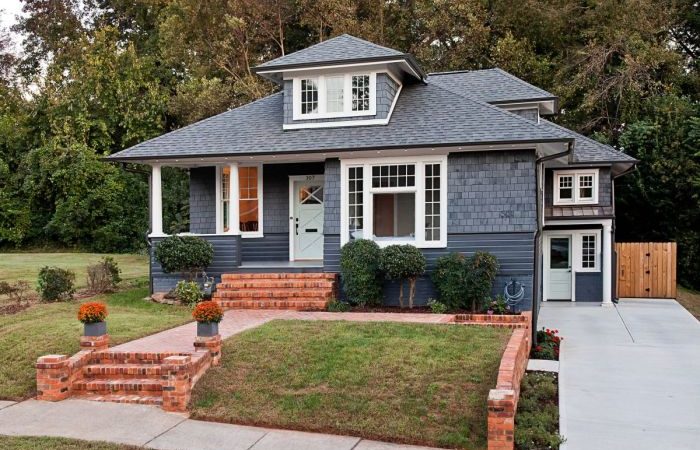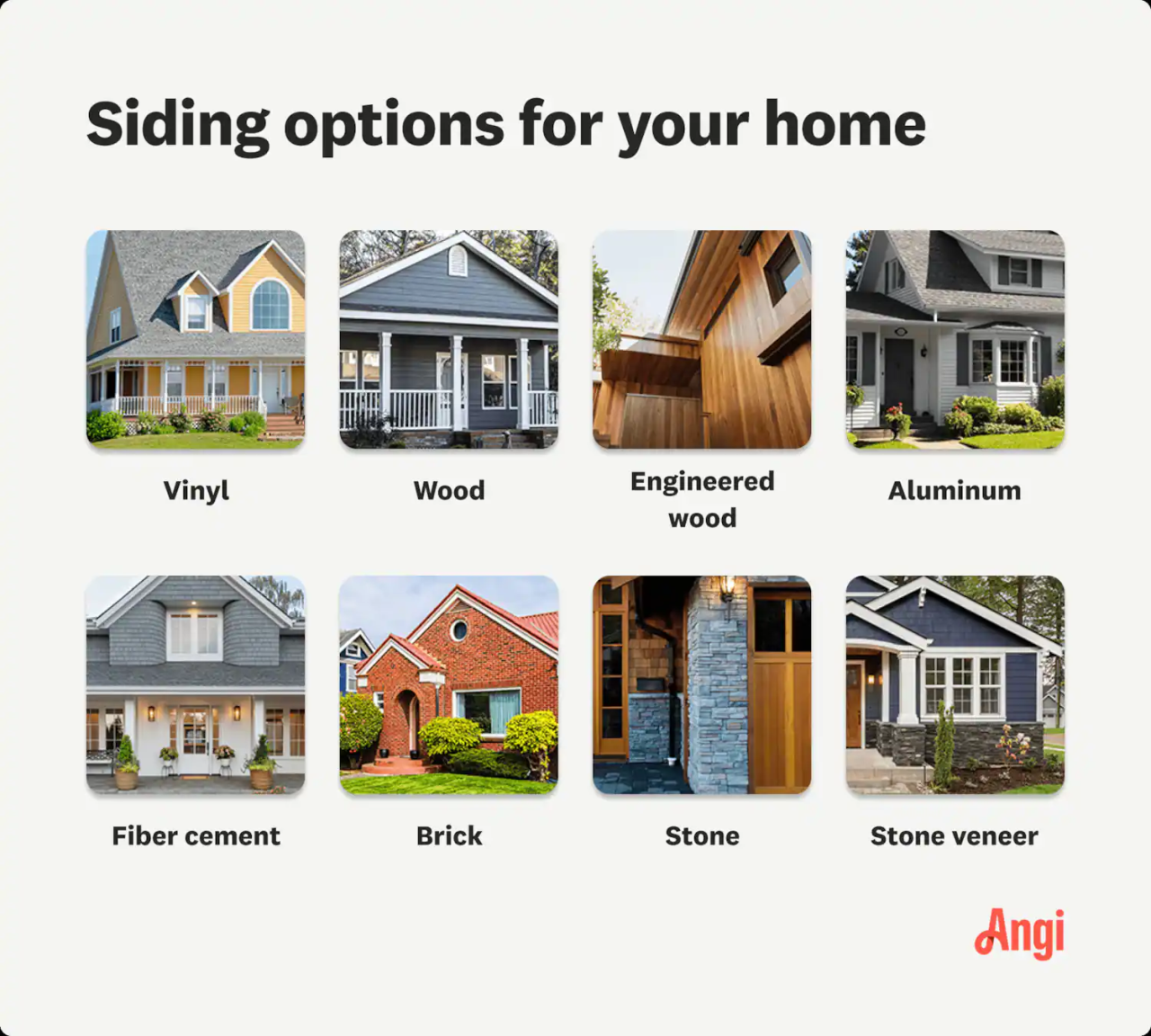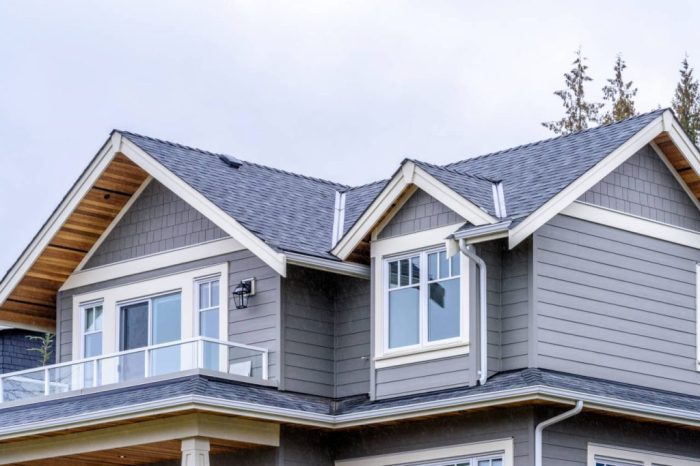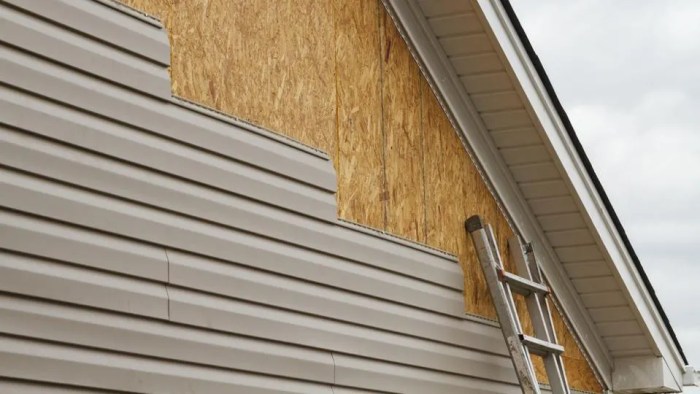Average Cost of New House Siding

Average cost of new siding for the house – Average cost of new siding for a house? It’s a big question with a surprisingly wide range of answers! This depends heavily on factors like the size of your home, the materials you choose (vinyl, wood, fiber cement, metal – each has its pros and cons!), and where you live. We’ll break down the costs, explore different siding options, and help you navigate the process of getting your house looking fresh and modern.
We’ll cover everything from material costs and labor fees to permits and potential hidden expenses. Understanding these factors is crucial for budgeting and planning your project effectively. By the end, you’ll have a much clearer picture of what to expect and how to make informed decisions about your new siding.
Types of Siding Materials
Choosing the right siding for your house is a significant decision impacting both aesthetics and longevity. Several factors influence this choice, including budget, desired lifespan, maintenance preferences, and the overall style of your home. Understanding the pros and cons of different materials is crucial for making an informed decision.
Siding Material Comparison
The table below summarizes the key characteristics of common siding materials. Remember that prices can vary based on location, installer, and specific product features.
| Material | Lifespan (Years) | Maintenance | Average Cost per Square Foot ($) |
|---|---|---|---|
| Vinyl | 20-40 | Low; occasional cleaning | $3-$8 |
| Wood | 30-50+ (with proper maintenance) | High; regular painting, staining, and sealing | $7-$15+ |
| Fiber Cement | 50+ | Medium; occasional cleaning and repainting | $8-$15+ |
| Metal (Aluminum or Steel) | 40-75+ | Low; occasional cleaning | $10-$20+ |
Pros and Cons of Each Siding Material
A balanced perspective considers both the advantages and disadvantages of each option.
Vinyl siding offers affordability and low maintenance. However, it’s less durable than other options and can be susceptible to damage from impact. Wood siding provides a classic, natural look but requires significant maintenance to prevent rot and insect damage. Fiber cement combines the durability of cement with the aesthetic appeal of wood, offering a long lifespan but at a higher initial cost. Metal siding boasts exceptional durability and longevity, often exceeding 50 years, but can be more expensive and may dent or scratch.
Visual Representation of Average Cost
Imagine four bars representing the average cost per square foot. The shortest bar represents vinyl siding, ranging from $3 to $8. Next, slightly taller, is fiber cement, ranging from $8 to $15. Wood siding has a bar of similar height to fiber cement, ranging from $7 to $15, but can significantly exceed this depending on the wood type and finish. Finally, the tallest bar is for metal siding, ranging from $10 to $20, reflecting its higher initial investment. The actual height of each bar would be proportional to the price range indicated.
Factors Affecting Total Cost

Source: angi.com
Getting new siding is a significant investment, and the final price tag depends on several interwoven factors. Understanding these factors will help you budget effectively and avoid unpleasant surprises during your project. This section breaks down the key elements influencing the overall cost of your new siding.
Several key aspects contribute to the final cost of your siding project. These include the cost of materials, labor, necessary permits, and the preparation work required before installation can even begin. The size and complexity of your project, as well as your geographic location, will also significantly impact the total expense.
Project Size and Complexity
The size of your house directly impacts material and labor costs. A larger house naturally requires more siding, increasing material expenses. Similarly, more siding means more labor hours, driving up the labor cost. The complexity of the job also plays a significant role. For example, removing old siding adds considerable time and labor to the project, increasing the overall cost. A simple installation on a straightforward house will cost less than a complex project involving intricate architectural details or extensive repairs to underlying structures.
- A small, single-story house with simple siding will generally cost less than a large, multi-story home with complex architectural features.
- Removing existing damaged siding, which often requires extra labor for disposal and potential repairs to the underlying wall sheathing, will increase the overall cost.
- Projects requiring extensive repairs to the house’s exterior before siding installation (such as rotted wood repair) will significantly increase the cost.
Material Costs
Siding materials vary widely in price, depending on the type of material and its quality. High-end materials, such as fiber cement or certain types of wood siding, will be more expensive than vinyl or aluminum siding. The cost per square foot also fluctuates based on current market conditions and availability.
- Vinyl siding is generally the most affordable option, but may not be as durable as other materials.
- Fiber cement siding offers excellent durability and longevity, but comes with a higher price tag.
- Wood siding, especially high-quality options like cedar, can be very expensive, particularly if it requires specialized installation techniques.
Labor Costs
Labor costs are a significant portion of the overall project expense. The hourly rate for siding installers varies based on geographic location, experience, and the demand for their services. The complexity of the job also influences labor costs. A simple installation on a flat-surfaced house will be less expensive than a project involving intricate details or challenging angles.
- Experienced and highly-skilled installers often command higher hourly rates.
- Labor costs are typically higher in areas with a high cost of living.
- Complex installations, such as those involving multiple siding types or intricate trim work, will require more labor hours and therefore increase the overall cost.
Permits and Preparation Work
Obtaining the necessary permits for your siding project is a crucial step. Permit costs vary significantly by region and the specific requirements of your local building codes. Preparation work, such as cleaning the existing siding, repairing damaged areas, or installing flashing, also adds to the overall cost. These preparatory steps are essential for a long-lasting and high-quality installation, and should not be overlooked.
- Permitting fees vary widely depending on location and the scope of the project; some areas may require multiple permits.
- Preparation work, such as cleaning and repairing the existing siding, can add several hundred to thousands of dollars to the project’s cost, depending on the extent of the damage.
- Failure to obtain necessary permits can result in fines and delays, significantly impacting the overall project cost and timeline.
Geographic Location
Your geographic location influences both material and labor costs. Areas with high costs of living tend to have higher labor rates for contractors. Transportation costs for materials may also be higher in remote areas. Supply and demand for specific siding materials can also fluctuate regionally, affecting pricing.
- Labor rates are typically higher in urban areas compared to rural areas.
- The cost of materials can be affected by transportation costs and local supply and demand.
- Certain materials may be more readily available or less expensive in specific regions.
Labor Costs and Contractor Selection: Average Cost Of New Siding For House
Labor costs represent a significant portion of your total siding project expense. Understanding how contractors price their services and choosing the right professional is crucial for staying within budget and ensuring quality workmanship. Different contractors utilize various pricing structures, and the overall cost can vary depending on the contractor’s experience and specialization.
Choosing between a general contractor and a specialized siding installer involves weighing several factors. General contractors manage the entire project, potentially coordinating multiple subcontractors. This can offer convenience but might lead to higher overhead costs. Specialized siding installers, on the other hand, focus solely on siding, often possessing greater expertise and potentially offering more competitive pricing for the siding installation itself. However, you’ll need to manage other aspects of the project separately.
Contractor Pricing Structures
Contractors typically use one of three main pricing methods: hourly rates, per-square-foot pricing, and fixed-price contracts. Hourly rates offer transparency but can be unpredictable in terms of total cost, especially for larger projects. Per-square-foot pricing provides a more upfront estimate, but it might not accurately reflect the complexity of the job or variations in material costs. Fixed-price contracts offer certainty in the total cost but require a detailed scope of work upfront, leaving little room for unforeseen changes. Choosing the best method depends on the project’s complexity and your comfort level with potential cost fluctuations. For example, a simple siding replacement on a small house might be well-suited to a per-square-foot estimate, while a complex renovation involving multiple materials and structural repairs might necessitate a fixed-price contract with detailed specifications.
General Contractor vs. Specialized Siding Installer
General contractors oversee all aspects of a construction project, including hiring and managing subcontractors for siding, roofing, electrical work, and more. They manage the scheduling and coordination of all these trades. This convenience comes at a cost – their fees often include a markup on the subcontractors’ labor. Specialized siding installers, conversely, focus exclusively on siding installation. Their expertise often translates to faster, more efficient work, and potentially lower labor costs than using a general contractor who subcontracts the work. However, you would need to separately manage other aspects of the project, such as electrical work if needed. The best choice depends on the project’s scope and your project management capabilities. A large-scale renovation might benefit from a general contractor’s organizational skills, whereas a straightforward siding replacement might be efficiently handled by a specialized installer.
Average Hourly Rates for Siding Installation Trades
Understanding the average hourly rates for different trades involved in siding installation can help you budget effectively. These rates can vary significantly based on location, experience, and demand.
| Trade | Average Hourly Rate (USD) | Geographic Variation | Notes |
|---|---|---|---|
| Carpenter (Siding Installer) | $40 – $70 | Higher in major metropolitan areas, lower in rural areas | Experience significantly impacts rate. |
| Electrician (for exterior lighting) | $50 – $80 | Similar to carpenters, higher in densely populated regions. | Rates increase for specialized work. |
| Drywaller (for repairs) | $45 – $75 | Significant variation depending on local market conditions. | Only needed if significant wall repairs are necessary. |
| Painter (for trim and finishing) | $35 – $60 | Dependent on demand and cost of living. | May be included in siding installer’s price or billed separately. |
Estimating Project Costs

Source: inchcalculator.com
Getting an accurate estimate for your new siding project is crucial for budgeting and avoiding surprises. This involves understanding your home’s square footage, choosing your siding material, and factoring in labor and potential hidden costs. Let’s break down how to do it effectively.
Estimating the cost of your siding project involves a straightforward calculation based on the square footage of your home’s exterior walls and the cost per square foot of your chosen siding material. This cost per square foot will include both the material itself and the labor required for installation. Remember to always get multiple quotes from different contractors to compare prices and ensure you’re getting a fair deal.
Cost Estimation Example
Let’s say your house has 1500 square feet of siding. You’ve chosen vinyl siding, which has an average installed cost of $8 per square foot (this is a broad average and can vary significantly based on location and contractor). The calculation would be:
1500 square feet x $8/square foot = $12,000
This is a rough estimate. The actual cost might vary depending on factors such as the complexity of your home’s design (many angles, dormers, etc.), the need for extra labor (removing old siding, extensive repairs), and the contractor’s overhead.
Labor Versus Material Costs, Average cost of new siding for a house
Typically, the cost breakdown for a siding project is roughly 50% labor and 50% materials. However, this can fluctuate. More complex projects might have a higher labor percentage, while simpler projects with inexpensive materials might have a higher materials percentage. For example, using a premium material like cedar might skew the balance towards higher material costs, while a complex Victorian-style house will likely have higher labor costs due to the intricate work involved.
Potential Hidden or Unexpected Costs
It’s wise to anticipate some unforeseen expenses. Here are some possibilities:
Failing to account for these extra costs can significantly impact your budget. It’s always best to overestimate rather than underestimate to avoid financial strain during the project.
- Permits and Inspections: Building permits are usually required, and these vary in cost by location.
- Repair of Underlying Issues: Discovering rotted wood or damaged sheathing during siding removal can add significant repair costs.
- Waste Removal: Disposal of old siding and other debris generates extra fees.
- Unexpected Material Needs: You might need more materials than initially estimated due to unforeseen circumstances like damaged or unusable pieces.
- Changes in Scope: Adding or changing elements during the project (e.g., adding extra trim) will inflate the final cost.
- Difficult Access: Homes with difficult-to-reach areas might require specialized equipment or techniques, increasing labor costs.
Financing Options

Source: forbes.com
Paying for new siding can be a significant investment, so understanding your financing options is crucial. Several avenues exist, each with its advantages and disadvantages concerning interest rates, repayment terms, and overall suitability for your financial situation. Choosing the right financing method can significantly impact your budget and overall project timeline.
Home siding projects often require substantial upfront capital. Carefully weighing the pros and cons of each financing option will help you make an informed decision that aligns with your financial goals and the scope of your project. Remember that securing multiple quotes from different contractors is a critical step before committing to any financing plan, as this allows for accurate cost comparisons and helps you choose the most financially viable option.
Home Equity Loans
Home equity loans use your home’s equity as collateral. This means you borrow against the value of your home, which you already own, to fund your siding project. Interest rates are generally lower than personal loans because the loan is secured by your property. However, the repayment terms can be longer, potentially leading to higher overall interest payments. A significant risk is that if you fail to repay the loan, your home could be at risk of foreclosure. It’s essential to carefully assess your home’s value and your ability to repay the loan before pursuing this option. For example, if you have $50,000 in equity and need $15,000 for siding, a home equity loan might be suitable.
Personal Loans
Personal loans are unsecured loans, meaning they don’t require collateral. This makes them more accessible than home equity loans, especially for those with limited home equity. However, interest rates tend to be higher than home equity loans due to the increased risk for the lender. Repayment terms are typically shorter than home equity loans, leading to quicker debt repayment but potentially higher monthly payments. Personal loans can be a viable option for smaller siding projects or for those who prefer shorter repayment periods. For example, if your siding project costs $10,000, a personal loan with a 5-year repayment term could be a suitable choice.
Contractor Financing Plans
Some contractors offer financing plans as part of their services. These plans often involve partnerships with lenders and may offer specialized terms or interest rates tailored to home improvement projects. The interest rates and repayment terms can vary widely depending on the contractor and lender involved. It’s vital to carefully review the terms and conditions of any contractor financing plan before agreeing to it. Comparing these offers with other financing options is crucial to ensure you’re getting the best possible deal. For example, a contractor might offer a 0% interest financing plan for a limited time, making it an attractive option compared to other loans.
Comparing Financing Options
The table below illustrates a comparison of typical interest rates and repayment terms for the different financing options discussed. These are just examples, and actual rates and terms can vary based on your credit score, the loan amount, and the lender.
| Financing Option | Typical Interest Rate Range | Typical Repayment Term |
|---|---|---|
| Home Equity Loan | 4% – 8% | 5 – 15 years |
| Personal Loan | 6% – 18% | 1 – 7 years |
| Contractor Financing | Variable | Variable |
End of Discussion

Source: homedit.com
Renovating your home’s exterior with new siding is a significant investment, but one that can dramatically improve its curb appeal and value. By carefully considering the various siding materials, factoring in labor costs, and planning for potential unexpected expenses, you can successfully manage your project and enjoy the beautiful results for years to come. Remember to get multiple quotes and explore financing options to find the best fit for your budget and timeline. Happy siding!
Comments are closed.